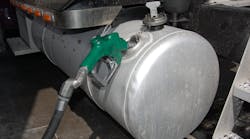Average retail pump prices for both diesel and gasoline increased this week across the U.S., according to data tracked by the Energy Information Administration (EIA); a symptom of a global oil market that’s become far more sensitive to pricing swings, noted the International Energy Agency (IEA) in a new report.
The national average for diesel climbed 4/10ths of a penny this week to $2.835 per gallon, EIA reported, though that is $1.142 per gallon cheaper compared to the same week in 2014.
Diesel prices were up in five U.S. regions while declining in four, the agency noted. Diesel exceeded the $3 per gallon market in three areas: California at $3.061 per gallon (up 3.4 cents this week); New England at $3.039 (up 1.1) and the Central Atlantic at $3.042 (up 1/10th of a penny).
The biggest one-week jump in diesel prices occurred on the West Coast, said EIA: up 3.8 cents to $2.924 per gallon with California included and up 4 cents to $2.756 with California removed from the mix.
The national average for gasoline jumped 12.3 cents this week to $2.191 per gallon, the agency reported, though that’s $1.118 per gallon cheaper compared to the same week in 2014.
Gasoline prices increased in every region of the country, with the Gulf Coast at $1.984 per gallon (up 12.4 cents this week) and the Rocky Mountains at $1.946 (up 7.9 cents) the only two areas where prices remained below the $2-per-gallon mark.
The biggest one-week jump in gasoline prices occurred on the West Coast, up 14.6 cents to $2.474 per gallon, and the Midwest, with a 13.7 cent hike to $2.166.
The IEA noted in its annual Medium-Term Oil Market Report that the recent crash in global oil prices that began last June is causing the crude market to “rebalance” in ways that will “challenge traditional thinking about the responsiveness” of supply and demand.
In particular, the U.S. “oil revolution” is making non-OPEC production more responsive to price swings than during previous market selloffs, adding that this would likely set the stage for a relatively swift price recovery. At the same time, lower oil prices will not provide as strong a boon to oil demand growth as might be expected, the group noted.
Here are some of the other findings from IEA’s analysis:
- Though supply will grow far more slowly than previously projected, global oil capacity will still expand by 5.2 million barrels per day by 2020.
- North America will remain a top source of oil supply growth for the remainder of the decade.
- In contrast, Russia faces a perfect storm of lower prices, sanctions and currency swings, pushing its production into contraction.
- OPEC’s share of global supply will inch up from recent lows but will not recover to the levels enjoyed before the surge in North American supply.
- Assuming that international sanctions on Iran remain in place, OPEC growth in crude production capacity is expected to be limited to 200 000 barrels per day per year. The overwhelming majority of that growth will come from Iraq and will thus be at significant risk as geopolitical instability there persists.
- Global oil demand is now expected to grow slightly faster than supply capacity, causing the market to gradually tighten from 2016 onwards.
- Political risk to supply will remain extraordinarily elevated in the next few years, both on the upside and the downside. Lower oil prices may heighten the risk of political disturbances in oil-export-dependent economies countries with low buffers, but can also offer an incentive to maximize output and stimulate production growth.



